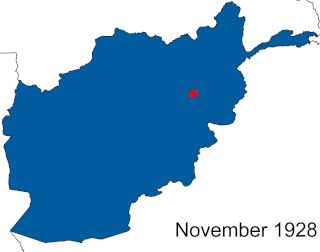
The Afghan Civil War was fought from 14 November 1928 to 13 October 1929. Rebelling, and subsequently governing Saqqawist (Saqāwīhā) forces under Habibullāh Kalakāni fought against various opposing tribes and rival monarchs in the Kingdom of Afghanistan, among whom Mohammed Nādir Khān eventually achieved a preponderant role. Despite early successes, such as the capture of Kabul and defeat of Amanullah Khan on 17 January 1929 or the capture of Kandahar on 3 June, the Saqqawists were eventually deposed by anti-Saqqawist forces led by Nadir on 13 October 1929, leading to Nadir's ascension as King of Afghanistan, who ruled until his assassination on 3 November 1933.

Ghazi Amanullah Khan was the sovereign of Afghanistan from 1919, first as Emir and after 1926 as King, until his abdication in 1929. After the end of the Third Anglo-Afghan War in August 1919, Afghanistan was able to relinquish its protected state status to proclaim independence and pursue an independent foreign policy free from the influence of the United Kingdom.

Habibullah Kalakani, derided by Pashtun as "Bacha-ye Saqao" was the ruler of Afghanistan from 17 January to 13 October 1929, and as well as a leader of the Saqqawists. During the Afghan Civil War, he captured vast swathes of Afghanistan and ruled Kabul during what is known in Afghan historiography as the "Saqqawist period". He was an ethnic Tajik. No country recognized Kalakani as ruler of Afghanistan.
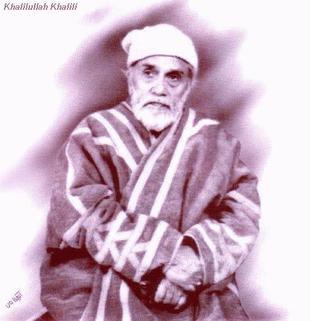
Khalilullah Khalili was Afghanistan's foremost 20th century poet as well as a noted historian, university professor, diplomat and royal confidant. He was the last of the great classical Persian poets and among the first to introduce modern Persian poetry and Nimai style to Afghanistan. He had also expertise in Khorasani style and was a follower of Farrukhi Sistani. Almost alone among Afghanistan's poets, he enjoyed a following in Iran where his selected poems have been published. His works have been praised by renowned Iranian literary figures and intellectuals. Many see him as the greatest contemporary poet of the Persian language in Afghanistan. He is also known for his major work "Hero of Khorasan", a controversial biography of Habībullāh Kalakānī, Emir of Afghanistan in 1929.
The following lists events that happened during 1929 in Afghanistan. The Afghan Civil War continued from the previous year.
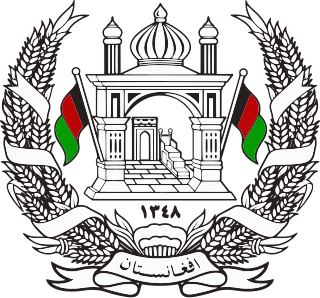
The Barakzai dynasty also known as the Muhammadzai dynasty ruled modern day Afghanistan from 1823 to 1978 when the monarchy ended de jure under Musahiban Mohammad Zahir Shah and de facto under his cousin Sardar Mohammad Daoud Khan. The Barakzai dynasty was established by Dost Mohammad Khan after the Durrani dynasty of Ahmad Shah Durrani was removed from power. As the Pahlavi era in Iran, the Muhammadzai era was known for its progressivist modernity in which Afghanistan was referred to as the "Switzerland of South Asia".
The Kabul Airlift was an air evacuation of British and a number of European diplomatic staff and their families conducted by the Royal Air Force from Kabul between 23 December 1928 and 25 February 1929, the first large-scale air evacuation, with a total of 586 people of eleven different nationalities being rescued and taken to India. The evacuation was conducted after forces of a bandit, Habibullah Kalakani, attacked Kabul in opposition to the Afghan king, Amanullah, leading to British fears that its legation would be isolated and cut off.
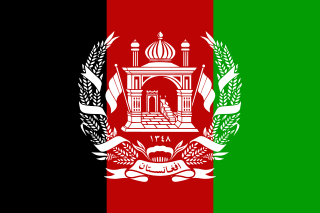
The Kingdom of Afghanistan was a constitutional monarchy in Central Asia established in 1926 as a successor state to the Emirate of Afghanistan. It was proclaimed by its first king, Amanullah Khan, seven years after he acceded to the throne. The monarchy ended in the 1973 Afghan coup d'état.

Mohammad Nadir Shah was King of Afghanistan from 15 October 1929 until his assassination in November 1933. Previously, he served as Minister of War, Afghan Ambassador to France, and as a general in the Royal Afghan Army. He and his son Mohammad Zahir Shah, who succeeded him, are part of the Musahiban.
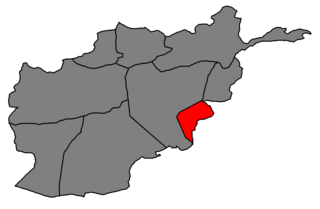
The Khost rebellion, also known as the 1924 Mangal uprising, the Khost revolt or the Mangal Revolt was an uprising against the Westernization and modernizing reforms of Afghanistan’s king, Amanullah Khan. The uprising was launched in Southern Province, Afghanistan, and lasted from March 1924 to January 1925. It was fought by the Mangal Pashtun tribe, later joined by the Sulaiman Khel, Ali Khel, Jaji, Jadran and Ahmadzai tribes. After causing the death of over 14,000 Afghans, the revolt was finally quelled in January 1925.

Amir Ali Ahmad Khan, Shaghasi was an Afghan king from the Shaghasi family of the Barakzai tribe who was declared king of Afghanistan twice in 1929. He was first declared amir of Afghanistan by and influential cleric, Naqib Sahib on 20 January 1929, in eastern Afghanistan, but was defeated by Kalakani at Jagdalak on 19 February 1929. He was also declared as the amir of Afghanistan for the second time on 23 June 1929 in Kandahar, Afghanistan, by another highly influential Mufti Abd. Wasi Kandahari, but was defeated and captured by Kalakani on 3 July 1929.
The Afghan-German Trading Company, originally known as the German and Oriental Trade House is a trading company which was established in 1923 by an association of German enterprises, which had its office in Kabul.

The Saqqawists were an armed group in Afghanistan who were active from 1924 to 1931. They were led by Habibullāh Kalakāni, and in January 1929, they managed to take control of the capital of the Kingdom of Afghanistan, Kabul, reestablishing the Emirate of Afghanistan. Following military reversals in the Afghan Civil War (1928–1929), they were forced out of the capital in October 1929. Saqqawist activity ended in 1931.

The Emirate of Afghanistan was an unrecognized state ruled by the Saqqawists that existed from January to October 1929. Habibullāh Kalakāni became the state's only emir on 18 January 1929. After the fall of Kalakāni on 13 October 1929, the Emirate ended.
Sarwar Sultana Begum or, was an Afghan royal consort. She was married to Habibullah Khan, and was the mother of king Amanullah Khan.
Princess Sahira Begum Siraj Al Banat or Bibi Gul, mostly known as just Seraj al-Banat, was a royal princess of Afghanistan.
Purdil Khan was an Afghan Saqqawist politician who served as minister of defence under Habibullāh Kalakāni during the Afghan Civil War of 1928–29, and briefly became the leader of the movement during a rebellion in July 1930.
Sayyid Husayn was an Afghan Saqqawist politician who served as minister of defence from January to March 1929. He was appointed by Habibullāh Kalakāni immediately following the capture of Kabul in January 1929 during the Afghan Civil War. In March 1929, he was succeeded by Purdil Khan.
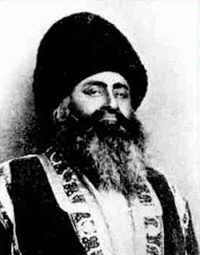
Shaghasi are alongside the Seraj and Telai a prominent and powerful cadet-branch of the Afghan Royal Family. They belong to the Zirak branch of the Durrani confederacy, and are primarily centered around Kandahar. They can also be found in other provinces throughout central Afghanistan.












